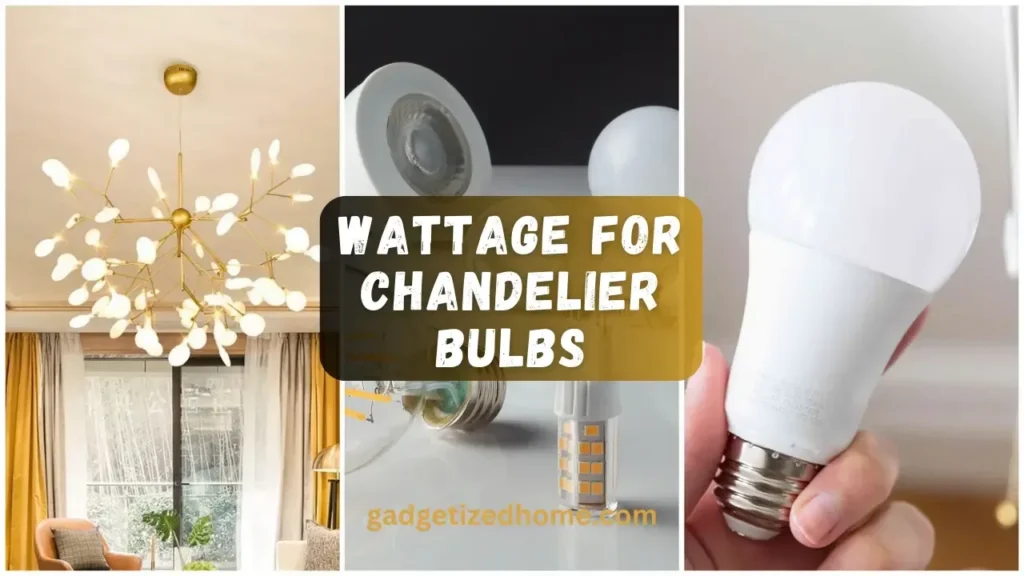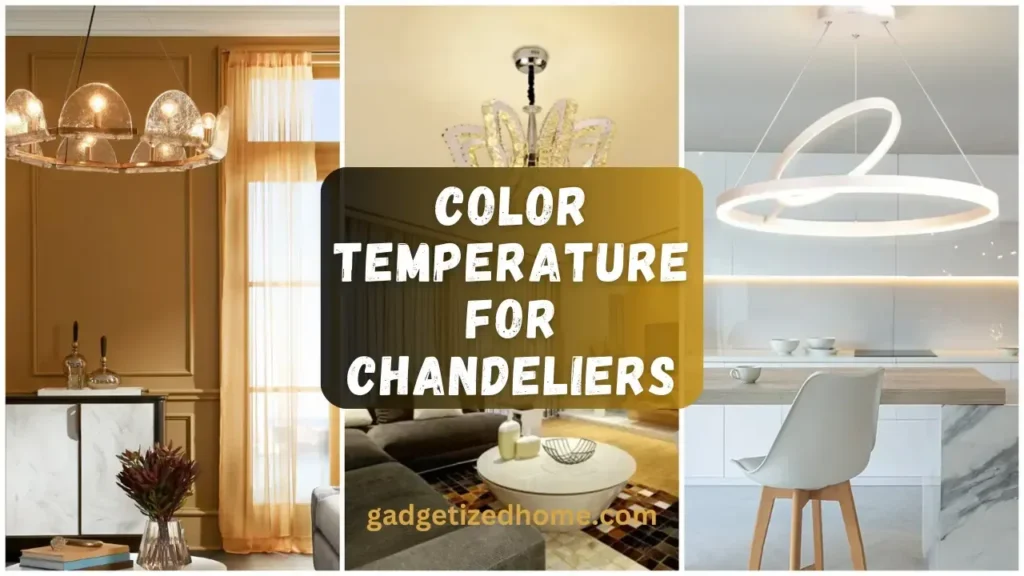When choosing the right chandelier, selecting the perfect bulbs is just as important as picking the fixture itself. The bulbs you choose impact not only the look of the chandelier but also the ambiance and functionality of the room.
Two key factors to consider are wattage and color temperature—both of which determine the brightness, energy consumption, and overall feel of your space.
In this guide, we’ll explore How to Choose the Ideal Wattage and Color Temperature for your Chandelier, ensuring it enhances your home’s style while providing the perfect light for any setting.
Why Bulb Selection Matters for Chandeliers
The right bulb choice can significantly impact how your chandelier looks and functions. Selecting the right wattage and color temperature ensures that your chandelier not only complements your room’s design but also creates the desired atmosphere.
- Aesthetic Impact: Bulbs influence how the chandelier interacts with the surrounding decor. A soft, warm bulb can enhance a cozy, intimate environment, while a bright, cool light can make the space feel more modern and vibrant. The right choice highlights the beauty of the chandelier itself, whether it’s a crystal masterpiece or a sleek modern design.
- Energy Efficiency: Choosing energy-efficient bulbs like LEDs can drastically reduce energy consumption, saving you money on electricity bills over time. LED bulbs use less wattage while still providing ample light, making them an ideal choice for multi-bulb chandeliers where efficiency is key.
- Safety Concerns: Using the wrong bulb—especially one with a higher wattage than recommended—can overheat the fixture, potentially causing damage or even a fire hazard. Proper bulb selection ensures your chandelier operates safely, protecting both the fixture and your home from potential issues.
Understanding Wattage for Chandelier Bulbs

Wattage plays a crucial role in determining the brightness of your chandelier and its energy consumption. Understanding how wattage works will help you choose bulbs that provide the perfect balance of light and efficiency for your space.
What is Wattage?
Wattage refers to the amount of energy a bulb utilizes. In the past, incandescent bulbs had high wattages to produce bright light, but with modern bulbs like LEDs, you can achieve the same brightness with much lower wattage. For example, a 60-watt incandescent bulb can be replaced by a 9-12 watt LED bulb, saving energy without sacrificing light output.
Choosing the Correct Wattage
- Manufacturer’s Recommendations: Every chandelier has a recommended maximum wattage for the bulbs it can safely handle. Always follow this guideline to avoid overheating the fixture.
- Low Wattage Risks: Using bulbs with wattage lower than recommended may result in insufficient light for the space, making your room feel dim or underlit.
- High Wattage Dangers: Exceeding the wattage limit can cause bulbs to overheat, which not only risks damaging the chandelier but also creates a potential fire hazard.
Dimming Capabilities
If your chandelier is connected to a dimmer switch, it’s important to choose bulbs that are dimmable. LED bulbs, for instance, often come in dimmable options, allowing you to adjust the brightness to suit your mood or occasion. Pairing the right wattage with dimmable bulbs gives you control over how much light the chandelier emits, enhancing both ambiance and energy savings.
Looking for stylish lighting on a budget? Check out our blog on the 8 Best Cheap Chandeliers under $100, where we feature affordable yet chic chandeliers that can transform your space without breaking the bank.
Common Wattage Recommendations for Various Chandelier Types
- Small Chandeliers: These often work best with bulbs between 40-60 watts (or LED equivalents), providing enough light without overpowering smaller spaces like bedrooms or hallways.
- Large Statement Chandeliers: In large spaces like dining rooms or living areas, 60-100 watt bulbs (or LED equivalents) may be needed to properly illuminate the room.
- Multi-Light Chandeliers: For fixtures with multiple bulbs, consider using lower-wattage bulbs (like 40 watts or less) to prevent excessive brightness while maintaining energy efficiency.
By understanding wattage and selecting the appropriate level for your chandelier, you’ll ensure that your fixture provides ample lighting while remaining safe and efficient.
Understanding Color Temperature for Chandelier Bulbs

Color temperature is another crucial factor when choosing bulbs for your chandelier. Measured in Kelvins (K), it determines the appearance of light—from warm, yellowish tones to cool, bluish hues—and plays a significant role in shaping the mood and ambiance of a room.
What is Color Temperature?
Color temperature refers to the warmth or coolness of light emitted by a bulb, with lower Kelvin values producing warmer light and higher values resulting in cooler light. The Kelvin scale typically ranges from 2700K (warm) to 5000K+ (cool), and choosing the right temperature depends on the function and design of the room.
- Warm Light (2700K – 3000K): This soft, yellowish light creates a cozy, intimate atmosphere, making it ideal for spaces like living rooms, dining areas, and bedrooms. It evokes a welcoming, relaxed feel and is perfect for more traditional or rustic chandelier designs.
- Neutral Light (3500K – 4000K): This balanced, neutral white light is great for spaces where both warmth and clarity are needed. It works well in areas like kitchens, where task lighting is important but you still want a comfortable atmosphere.
- Cool Light (4000K – 5000K+): Bright, crisp light with a bluish tint that’s best suited for workspaces or modern, minimalist designs. It’s perfect for areas requiring high visibility, such as kitchens, bathrooms, or offices, and it complements contemporary chandeliers with sleek or industrial styles.
Choosing the Right Color Temperature for Chandeliers
- Warm vs. Cool Light: The choice between warm and cool lighting largely depends on the room’s purpose and decor. Warm light is ideal for creating cozy, intimate spaces, while cool light is better for brighter, more energetic environments.
- Room Functionality:
- Living Rooms and Bedrooms: Typically benefit from warm light, as these spaces are meant for relaxation.
- Dining Rooms: Often use a warmer range (2700K – 3000K) to create a welcoming atmosphere.
- Kitchens and Bathrooms: A cooler color temperature (4000K+) provides better task lighting for cooking or grooming.
Impact of Color Temperature on Room Ambiance
Color temperature directly influences the feel of a room. Warm light can make a space feel inviting and cozy, while cool light can make it feel modern, open, and functional. It’s important to match the color temperature with the overall decor and purpose of the space.
Color Temperature Recommendations by Room and Chandelier Type
- Living Rooms: 2700K – 3000K for a soft, warm glow that encourages relaxation.
- Dining Rooms: 3000K for a balanced light that enhances the dining experience without being too harsh.
- Kitchens: 3500K – 4000K for clear, functional light that supports visibility during tasks.
- Modern Chandelier Designs: Often look best with cooler temperatures (4000K+) to highlight the clean, sharp lines.
By choosing the right color temperature, you’ll enhance both the functionality and aesthetic of your chandelier, ensuring it creates the desired ambiance while complementing your room’s design.
For a touch of elegance and sparkle, explore our blog on the 9 Best Modern Crystal Chandeliers. These stunning fixtures will add a luxurious feel to any room, combining modern design with the timeless beauty of crystal.
Types of Bulbs for Chandeliers
Choosing the right type of bulb is essential for achieving the desired look, energy efficiency, and functionality of your chandelier. Here are the most common types of bulbs used in chandeliers:
1. Incandescent Bulbs
- Traditional Look: Known for their warm, soft light, incandescent bulbs are a classic choice for chandeliers, especially in traditional settings.
- Shorter Lifespan: These bulbs consume more energy and have a shorter lifespan compared to modern alternatives.
- Ideal For: Vintage or classic chandeliers where ambiance is prioritized over energy efficiency.
2. LED Bulbs
- Energy Efficient: LED bulbs use significantly less power and last much longer than incandescent bulbs.
- Variety of Colors: Available in various color temperatures, from warm to cool, making them versatile for different rooms and styles.
- Dimmable Options: Many LED bulbs are dimmable, offering flexibility for chandeliers with dimmer switches.
- Ideal For: Modern or contemporary chandeliers where energy savings and long-term durability are important.
3. Halogen Bulbs
- Bright and Clear: Halogen bulbs produce bright, crisp light that enhances the clarity of the space.
- High Heat Output: They run hotter than LEDs, which can affect the chandelier’s material and surrounding area.
- Ideal For: Chandeliers in spaces that require bright, focused light, such as kitchens or work areas.
4. CFL (Compact Fluorescent Light) Bulbs
- Energy Efficient: CFLs are more efficient than incandescent bulbs, though they aren’t as popular as LEDs.
- Slower Warm-Up: They take a moment to reach full brightness and may not work with all dimmer switches.
- Ideal For: Chandeliers where energy savings are important but frequent switching or dimming is less of a concern.
5. Smart Bulbs
- Customizable Lighting: These bulbs allow you to adjust brightness and color temperature via smartphone apps or voice controls.
- Energy Efficient: Most smart bulbs are LED-based, combining energy savings with advanced features.
- Ideal For: Smart homes and chandeliers in living areas where lighting control is desired.
Each bulb type offers different benefits, from energy efficiency to ambiance control. Choose based on your chandelier style, room needs, and energy preferences.
How to Pair Wattage and Color Temperature for Your Chandelier
Pairing the right wattage and color temperature ensures that your chandelier delivers optimal lighting and enhances your room’s atmosphere. Here’s how to strike the perfect balance:
1. Consider the Room’s Purpose
- Living Rooms and Bedrooms: Opt for lower wattage bulbs (40-60 watts or LED equivalents) with warm color temperatures (2700K-3000K) to create a cozy, relaxing environment.
- Dining Rooms: Use moderate wattage (60 watts or LED equivalents) with warm to neutral color temperatures (3000K) for a welcoming, intimate dining space.
- Kitchens and Bathrooms: Choose higher wattage (75-100 watts or LED equivalents) with cooler temperatures (3500K-5000K) to ensure bright, functional lighting for tasks.
2. Match with Chandelier Size
- Small Chandeliers: Use lower wattage and warmer color temperatures to avoid overpowering the space.
- Large Chandeliers: Higher wattage and neutral-to-cool temperatures work well in larger rooms, providing ample illumination without harshness.
3. Balance Ambiance and Efficiency
- Dimmable Settings: Use dimmable bulbs to adjust wattage and control the light’s intensity, allowing you to shift between bright task lighting and softer ambient light.
Pairing the right wattage and color temperature will help you achieve both functional lighting and a harmonious atmosphere that complements your chandelier and space.
Additional Tips for Choosing the Right Bulbs for Your Chandelier
When selecting bulbs for your chandelier, a few extra considerations can make a big difference in the overall effect. Keep these tips in mind:
- Check Compatibility: Ensure the bulbs fit your chandelier’s sockets and wattage limits.
- Dimmable Bulbs: Opt for dimmable bulbs if your chandelier is connected to a dimmer switch.
- Shape and Size: Choose bulbs that match the style and scale of your chandelier for a cohesive look.
- Clear vs. Frosted Bulbs: Clear bulbs provide brighter light and show off chandelier details, while frosted bulbs diffuse light for a softer glow.
- Energy Star Rating: Look for energy-efficient bulbs with an Energy Star rating to save on electricity costs.
- Avoid Overheating: Always follow the chandelier’s maximum wattage rating to prevent overheating.
Conclusion
Choosing the right bulbs for your chandelier, including the appropriate wattage and color temperature, is key to achieving both functionality and aesthetic appeal. By considering the room’s purpose, your chandelier’s style, and energy efficiency, you can create the perfect ambiance for any space.
Thanks for reading at Gadgetized Home, and we hope these tips help you illuminate your home beautifully!
FAQs
What watt bulbs should I use in my chandelier?
The wattage of the bulbs for your chandelier depends on its size and the room’s lighting needs. For small chandeliers, 40-60 watt bulbs (or LED equivalents) are usually sufficient. Larger chandeliers or those in bigger rooms may need 60-100 watt bulbs. Always check the manufacturer’s recommendations for the maximum wattage to ensure safety.
What is the best color temperature for a chandelier?
The best color temperature depends on the ambiance you want to create. For a cozy, warm atmosphere, go for bulbs with a color temperature of 2700K-3000K. If you want a more modern, bright look, especially for functional spaces like kitchens, choose 3500K-5000K bulbs. Warmer light is ideal for living and dining rooms, while cooler light works well in task-oriented areas.
Is 40W or 60W better for chandeliers?
Both 40W and 60W bulbs can work in chandeliers, depending on the room size and lighting needs. 40W bulbs provide a softer, more ambient light, ideal for smaller rooms or intimate spaces. 60W bulbs offer brighter illumination, making them better for larger areas or spaces where more light is needed. Consider using 40W for cozy settings and 60W for more visibility.
What bulbs look best in a chandelier?
The best bulbs for a chandelier are those that complement its style and the room’s ambiance. Clear bulbs are great for highlighting the chandelier’s details, especially in crystal or glass designs. Frosted bulbs diffuse light for a softer glow, which works well for traditional or vintage chandeliers. LED bulbs are highly recommended for their energy efficiency and long lifespan. Smart bulbs can add versatility and control to your lighting setup.
Recent Posts
- 10 Best Nesting Tables for Small Spaces and Apartments
- 10 Best Ladder Bookshelves for Stylish Home Organization
- 9 Best Storage Trunks for Home Organization and Style
- 10 Best Room Dividers for Privacy and Stylish Spaces
- 11 Best Bar Carts for Entertaining Guests in Style
- 10 Best Decorative Accent Cabinets for Stylish Home Storage
- 9 Best Convertible Futons and Sofa Beds for Small Apartments
- 10 Best Modular Furniture Sets for Flexible and Functional Living
- 10 Best Cube Storage Units for Organized and Stylish Homes
- 9 Best Closet Organizer Systems for Maximizing Your Space
- 10 Best Murphy Beds and Wall Beds for Small Guest Rooms
- 15 Best Folding Furniture Pieces for Small Apartments and Studios
- 12 Best Storage Ottomans for Small Spaces and Apartment Living
- 9 Best Activity Tables for Kids for Fun and Learning
- 9 Best Kids’ Dressers for Organized Bedrooms
Our Main Categories
Ceiling Lights
- Chandeliers
- Wheel Chandeliers
- Pendant Lights
- Flush Mount Lights
- Track Lights
- Recessed Lights
- Semi Flush Mount Lights
- Cove Lights
Ceiling Fans with Lights
- Indoor Ceiling Fans
- Outdoor Ceiling Fans
- Ceiling Fans Light Kits
- Ceiling Fans Accessories
Wall Lighting
- Flush Mount Wall Lighting
- Wall Sconces
- Night Lighting
- Picture Lights
- Swing Arm Lights
- Step Lights
- Hall Lights
- Swing Arm Lamps
Outdoor Lighting
- Outdoor Wall Lights
- Outdoor Ceiling Lights
- Landscape Lighting
- String Lights
- Post Lights
- Motion Sensor Lights
- Dusk to Dawn Lights
- Lanterns
- Garden Lights
- Barn Lights
Lamps and Lamp Shades
- Table Lamps
- Floor Lamps
- Lamp Sets
- Desk Lamps
- Reading Lights
- Book lights
- LED Lamps
- Lamp Shades
Kitchen Lights
- Kitchen Island Lights
- Under Cabinet Lights
- Over Sink Lighting
- Under Cabinet Strip Lights
- Inside Cabinet Lights
Bathroom Lighting
- Bathroom Vanity Lights
- Bathroom Sconces
Special Lights
- Smart Bulbs
- Energy Efficient Lights
- Christmas Lights
- Festive String Lights
- Solar Lights
















